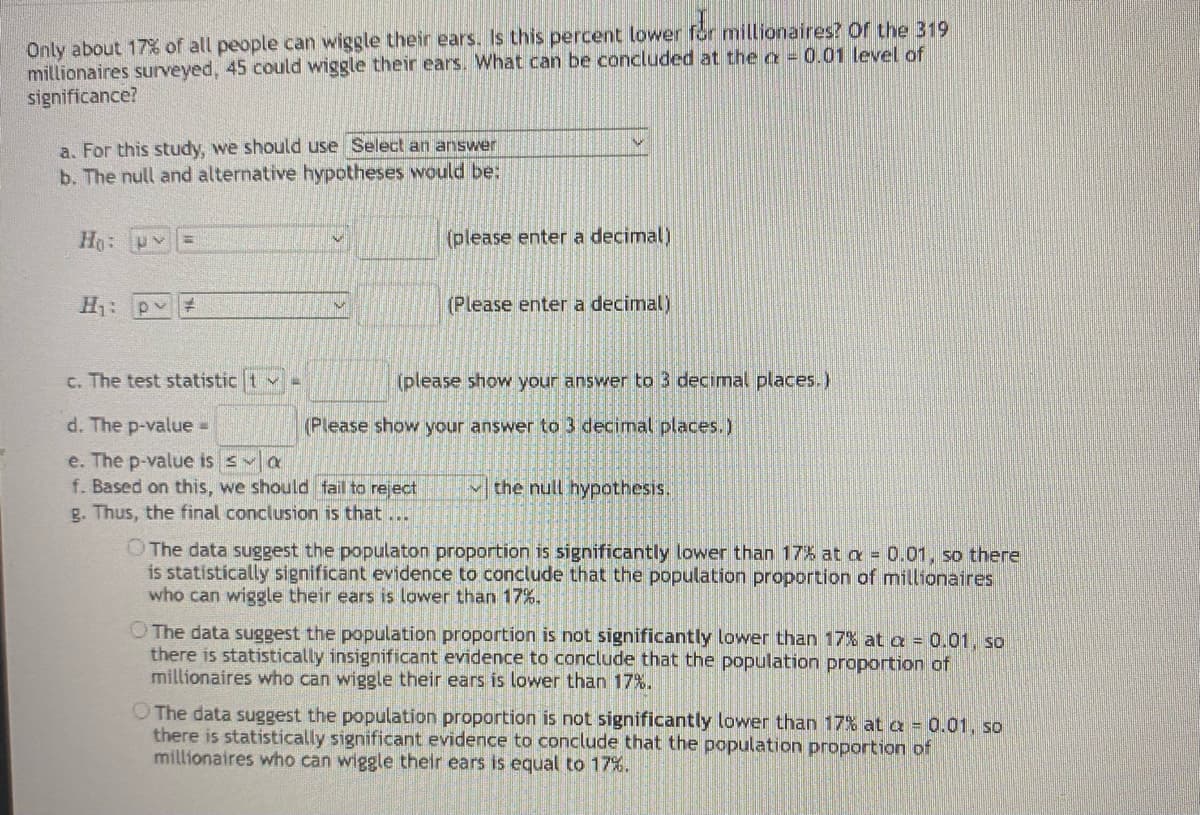Only about 17% of all people can wiggle their ears. Is this percent lower for millionaires? Of the 319 millionaires surveyed, 45 could wiggle their ears. What can be concluded at the a = 0.01 level of significance? a. For this study, we should use Select an answer b. The null and alternative hypotheses would be: Ho: (please enter a decimal) H1: (Please enter a decimal) c. The test statistic t v (please show your answer to 3 decimal places.) d. The p-value - (Please show your answer to 3 decimal places.) e. The p-value is sva f. Based on this, we should fail to reject g. Thus, the final conclusion is that ... v the null hypothesis. O The data suggest the populaton proportion is significantly lower than 17% at o = 0.01, so there is statistically significant evidence to conclude that the population proportion of millionaires who can wiggle their ears is lower than 17%. OThe data suggest the population proportion is not significantly lower than 17% at a = 0.01, so there is statistically insignificant evidence to conclude that the population proportion of millionaires who can wiggle their ears is lower than 17%. O The data suggest the population proportion is not significantly lower than 17% at a 0.01, so there is statistically significant evidence to conclude that the population proportion of millionaires who can wiggle their ears is equal to 17%.
Only about 17% of all people can wiggle their ears. Is this percent lower for millionaires? Of the 319 millionaires surveyed, 45 could wiggle their ears. What can be concluded at the a = 0.01 level of significance? a. For this study, we should use Select an answer b. The null and alternative hypotheses would be: Ho: (please enter a decimal) H1: (Please enter a decimal) c. The test statistic t v (please show your answer to 3 decimal places.) d. The p-value - (Please show your answer to 3 decimal places.) e. The p-value is sva f. Based on this, we should fail to reject g. Thus, the final conclusion is that ... v the null hypothesis. O The data suggest the populaton proportion is significantly lower than 17% at o = 0.01, so there is statistically significant evidence to conclude that the population proportion of millionaires who can wiggle their ears is lower than 17%. OThe data suggest the population proportion is not significantly lower than 17% at a = 0.01, so there is statistically insignificant evidence to conclude that the population proportion of millionaires who can wiggle their ears is lower than 17%. O The data suggest the population proportion is not significantly lower than 17% at a 0.01, so there is statistically significant evidence to conclude that the population proportion of millionaires who can wiggle their ears is equal to 17%.
Holt Mcdougal Larson Pre-algebra: Student Edition 2012
1st Edition
ISBN:9780547587776
Author:HOLT MCDOUGAL
Publisher:HOLT MCDOUGAL
Chapter11: Data Analysis And Probability
Section: Chapter Questions
Problem 8CR
Related questions
Question

Transcribed Image Text:Only about 17 of all people can wiggle their ears. Is this percent lower for millionaires? Of the 319
millionaires surveyed, 45 could wiggle their ears. What can be concluded at the a = 0.01 level of
significance?
a. For this study, we should use Select an answer
b. The null and alternative hypotheses would be:
Ho: py
(please enter a decimal)
%3D
H: p #
(Please enter a decimal)
c. The test statistic t v
(please show your answer to 3 decimal places.)
d. The p-value =
(Please show your answer to 3 decimal places.)
e. The p-value is s a
f. Based on this, we should fail to reject
g. Thus, the final conclusion is that...
the null hypothesis.
OThe data suggest the populaton proportion is significantly lower than 17% at a = 0.01, so there
is statistically significant evidence to conclude that the population proportion of millionaires
who can wiggle their ears is lower than 17%.
O The data suggest the population proportion is not significantly lower than 17% at a = 0.01, so
there is statistically insignificant evidence to conclude that the population proportion of
millionaires who can wiggle their ears is lower than 17%.
O The data suggest the population proportion is not significantly lower than 17% at a = 0.01, so
there is statistically significant evidence to conclude that the population proportion of
millionaires who can wiggle their ears is equal to 17%.
Expert Solution
This question has been solved!
Explore an expertly crafted, step-by-step solution for a thorough understanding of key concepts.
This is a popular solution!
Trending now
This is a popular solution!
Step by step
Solved in 4 steps

Recommended textbooks for you

Holt Mcdougal Larson Pre-algebra: Student Edition…
Algebra
ISBN:
9780547587776
Author:
HOLT MCDOUGAL
Publisher:
HOLT MCDOUGAL

College Algebra
Algebra
ISBN:
9781305115545
Author:
James Stewart, Lothar Redlin, Saleem Watson
Publisher:
Cengage Learning

Holt Mcdougal Larson Pre-algebra: Student Edition…
Algebra
ISBN:
9780547587776
Author:
HOLT MCDOUGAL
Publisher:
HOLT MCDOUGAL

College Algebra
Algebra
ISBN:
9781305115545
Author:
James Stewart, Lothar Redlin, Saleem Watson
Publisher:
Cengage Learning